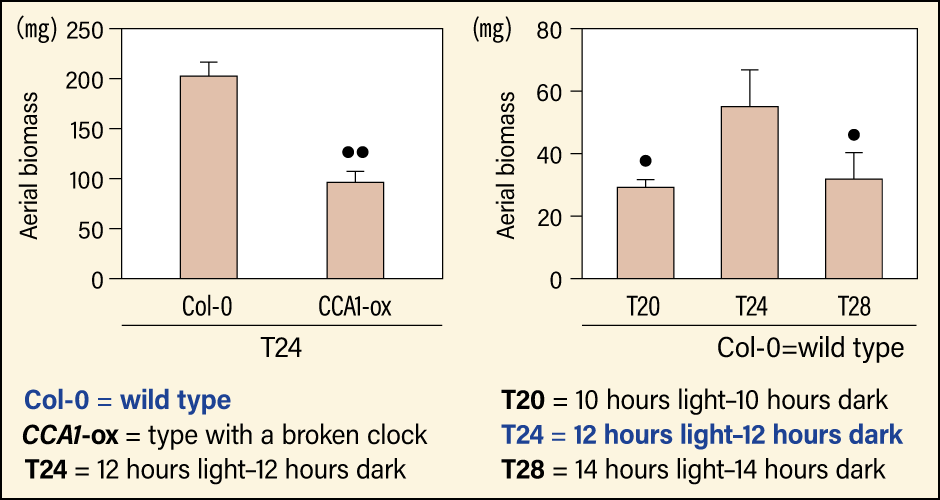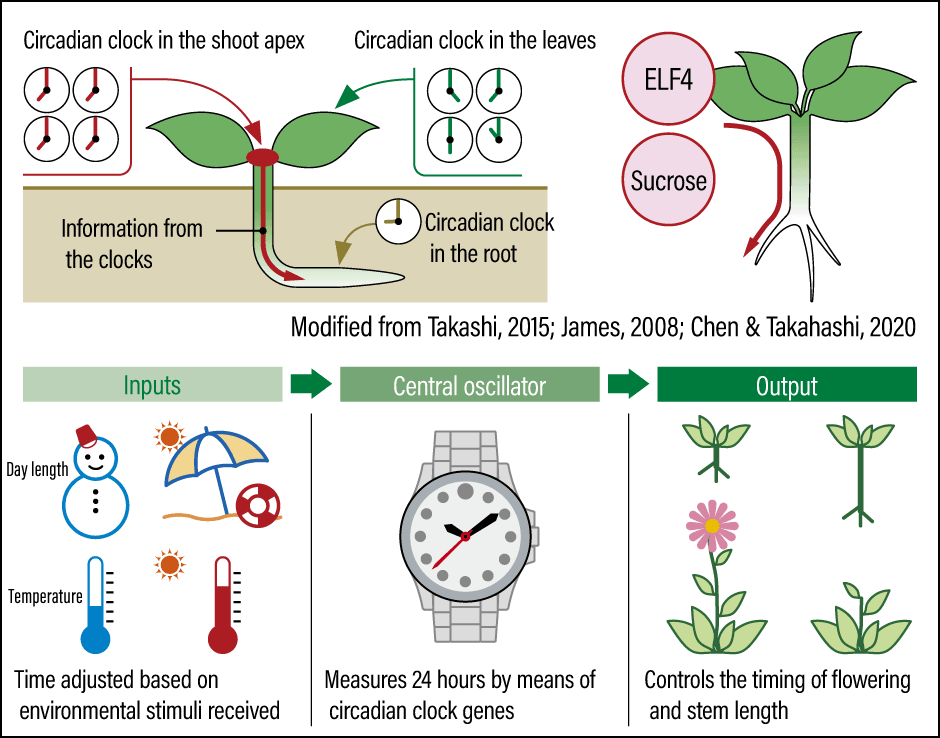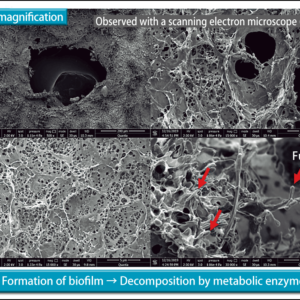Plants cannot uproot themselves to go and find the optimal environment for their survival. The circadian clock is a crucial survival strategy enabling plants to stay alive while they respond appropriately to a changing environment. Each cell has a clock gene, and these genes are thought to be synchronized somehow. How is the circadian clock involved in the physiological phenomena of plants? And given that plants do not have a central organ equivalent to the mammalian brain, how do they synchronize their multiple clocks?
Special Feature 1 – The Wondrous Survival Strategies of Plants The circadian clock —— the ingenious mechanism enables plants to survive changing natural environments
text by Toshiko Mogi
We humans are among many organisms that have a mechanism called body clock or biological clock, which regulates our biorhythm throughout our lives. Biological clocks with a cycle of approximately 24 hours are called circadian clocks. An example of a circadian clock is the one that causes us to wake in the morning and become sleepy at night. Thanks to the function of our circadian clock, we are well-tuned to the 24-hour cycle of day and night resulting from the earth’s rotation.
Where are a Plant’s control functions located?
Various organisms are equipped with a circadian clock. Studies of the circadian clock have been conducted not only in humans, but also in such organisms as mice, insects, plants, and cyanobacteria (prokaryotic algae that carry out photosynthesis in a similar way to plants). However, while they all have a system based on a 24-hour cycle, the genes (clock genes) used to operate that clock differ from one organism to another. It is therefore thought that organisms acquired their own circadian clocks separately over the course of evolution. To put it another way, one might say that the circadian clock is an essential mechanism for organisms to ensure the continuation of life in a constantly changing natural environment.
From research conducted to date, it has become clear that each and every cell has a circadian clock, and that there is some kind of “control tower” that synchronizes those clocks into the same rhythm. In the case of humans and other mammals, this control tower is located in the suprachiasmatic nucleus of the hypothalamus, on the underside of the central part of the brain, where it regulates the rhythms of every part of the body via a network of neurons.
However, in the case of plants, which are the focus of this special feature, there is no clear center equivalent to the mammalian brain. So, where is the circadian clock control tower located in plants? And how does it synchronize the clocks throughout the plant? Scientists at the Plant Physiology Laboratory at Nara Institute of Science and Technology were kind enough to answer these two questions for us. Assistant Professor Nozomu Takahashi provided explanations in easily comprehensible language, under the supervision of laboratory director Professor Motomu Endo.
Genes are a blueprint for producing the proteins essential to an organism’s makeup. There are various types of protein, each of which has its own crucial function. This is also true of the circadian clock: clock genes control the production of clock proteins that function as part of the circadian clock. The rhythm of the circadian clock originates in the synthesis of these clock proteins.
“The circadian clock is composed of a feedback loop mediated by gene transcription and translation,” Takahashi explains. “A feedback loop is a situation in which one gene cluster controls another gene cluster, which then feeds back to the original genes. It takes one day for this loop to complete one cycle.”
Translation is the process in which messenger RNA (mRNA) copies genetic information and proteins are synthesized by arranging amino acids on the basis of that information. Once the quantity of clock proteins reaches a certain level within the cell, they suppress mRNA transcription. When the quantity of clock proteins declines, mRNA transcription restarts and the clock proteins suffuse the cell again. As this cycle of clock protein synthesis and suppression lasts about 24 hours, the circadian clock’s daily rhythm is also about 24 hours.
The rhythms of the circadian clock and the habitat
The circadian clock in plants is equipped with a time adjustment function for the purpose of synchronization with changes in the surrounding light environment. When light is shone on plants after sunset, the circadian clock slows down; conversely, it speeds up in response to light at daybreak. Light has not yet been shed on the details of the mechanism behind this, but this time adjustment function that responds to external information enables the plant to distinguish between one o’clock in the morning and one o’clock in the afternoon.
“Plants gain information from the external environment in the form of light (i.e. light in the daytime and darkness at night) and temperature (i.e. temperature rises in the day and falls at night). Even when it is cloudy, there is more light than at night, so plants should be able to tell that it is not nighttime,” Takahashi says.
The key to plants’ survival is the fact that the rhythm of their circadian clock matches that of their habitat. Figure 1 shows the results of an experiment demonstrating this fact, conducted using Arabidopsis thaliana (an annual plant of the genus Arabidopsis, in the Brassicaceae family, which is used as a model organism in plant experiments). It features a comparison of the wild type, with a normal clock, and mutants with a broken clock. The vertical axis shows the growth of each type.
 Modified from Dodd, 2005
Modified from Dodd, 2005
Figure 1. The circadian clock is involved in improving fitness<Left> Arabidopsis thaliana with a broken circadian clock only grows about half the amount of the normal wild type. <Right> However, even in the wild type, growth is impaired if the 24-hour cycle of 12 hours of light and 12 hours of darkness is shortened or lengthened.
“In the graph on the left, the plants were exposed to a daily rhythm of 12 hours each of light and darkness. The wild type grew quickly, but the type with a broken clock demonstrated only half the level of growth.”
Using this as a model, the researchers then placed the wild type under environmental conditions with different rhythms, one with a 20-hour daily rhythm of 10 hours each of light and darkness, and one with a 28-hour rhythm of 14 hours each. The graph on the right shows a comparison of their growth. Under both of the altered rhythms, growth was about half compared to plants growing under a 24-hour rhythm.
“This shows that if the rhythm of the plant’s circadian clock matches that of the external environment, the plant will grow, but if they are out of sync, growth will be stunted.”
A complex network called the central oscillator regulates the rhythm of the 24-hour cycle and handles the recognition function for adjusting the time.
“Via sensor-like input systems for discerning the surrounding environment, plants obtain information about the time from environmental stimuli such as the length of the day. The central oscillator then runs on a cycle of about 24 hours based on this and uses the information presented to determine the timing of physiological phenomena such as the season when buds should be produced and the time when stems should grow.”
Takahashi gives the following example of the involvement of the circadian clock in plants.
“Plants cannot move from one place to another. However, it is not the case that they are completely motionless, like an ornament. Their leaves unfurl when the sun rises and close when the sun sets. The circadian clock is involved in these opening and closing movements of plants’ leaves.”
The opening and closing of leaves are essential to physiological functions such as photosynthesis and transpiration. This is because spreading their leaves enables plants to receive more of the light required for photosynthesis. The undersides of leaves have tiny pores called stomata, which open and close as they carry out transpiration and the gas exchange of carbon dioxide and water.
The opening and closing of these stomata are also under the control of the circadian clock. Takahashi also explains that, at the organ level, the circadian clock is involved in stem growth.
The circadian clock is also involved in determining the timing at which flowers bloom. The apex of the stem grows continuously while producing new leaves, but at a certain time, it will stop growing and produce flower buds that differ completely from leaves (flower bud differentiation). These will then go on to bloom. The circadian clock is involved in determining the timing at which the plant produces flower buds.
This is because the ability to flower enables the plant to give life to the next generation. Consequently, determining the timing of flower bud differentiation and flowering is vital.
“Experiments show that plants measure the length of the day at rigorously determined intervals of around 15 minutes and use this information to decide when to flower.”
Emitting defense chemicals at times when pests are likely to attack
A plant’s circadian clock also influences its relationships with other organisms in the external environment. Takahashi uses a well-known example to illustrate this.
“Plants emit aromatic compounds to attract insects that will assist in pollination. They actually emit these fragrances at times when the insects are most likely to visit the flowers.”
The circadian clock determines when to emit the scent, ensuring that it coincides with the timing of pollination (the advantage for the plant) and the collection of nectar (the advantage for the insect). Examples of the opposite phenomenon are often seen in the cultivation of vegetables such as lettuce and cabbage.
“As these plants do not want insects to eat their leaves, they have a mechanism via which they emit defense chemicals at times when pests are likely to attack them. An experiment found that when plants and insects are brought into contact with each other sharing the same rhythm of day and night, the insects do not eat the plants very much, because the plants emit defense chemicals. However, if this rhythm is changed so that it is daytime for the plants and nighttime for the insects, the insects arrive when the plants are not producing defense chemicals and the plants get consumed.”
The circadian clock merely controls the appropriate timing, so damage to the clock does not result in immediate death for the plant. However, the results of this experiment show that, in the longer term, a malfunction of the clock is disadvantageous to the Plant’s survival.
It was found that plants survive by responding appropriately to the information about the external environment they gain from stimuli such as light and temperature. So, where and how do plants capture information about light and temperature?
“That is actually the question we are trying to answer right now,” Dr. Takahashi says.
In fact, there has been little research of this kind in plants until recently. There are two key reasons for this. The first is that the circadian clocks in individual plant cells were thought to function independently. Consequently, most research used the whole plant. The second is that not only do plants not have an organ equivalent to the mammalian brain, but also each part of the plant is exposed to light, so it was thought that the clocks in individual cells all worked in the same way.
A research paper by Professor Endo made waves by disrupting this consensus. He measured the expression of clock genes in Arabidopsis thaliana, isolating tissue from the leaf as a whole, the mesophyll (the inner tissue that mainly performs photosynthesis), and the vascular bundle (through which water and nutrients pass). From this, he found that clock gene modes of expression in the leaf as a whole and the mesophyll were very similar, whereas the level and rhythm of expression in the vascular bundle differed from that in the mesophyll. In other words, just as in animals, the circadian clocks in plants are distinct in different tissues.
“This led to the discovery that different parts of the plant perceive and react to different stimuli (information from the external environment). For example, the circadian clock in the epidermis of the leaf reacts to temperature stimulus, determining the growth of the stem. The vascular bundles perceive the length of the day and are thought to be involved in determining the timing of flowering in response to that length.”
But why is the circadian clock rhythm not disrupted by the reaction of different parts to different stimuli? Do the cells in different parts of the plant somehow communicate with each other? And if so, how do they exchange information? Takahashi’s research aims to unravel these questions.
Presence of intercellular networks
“Using Arabidopsis thaliana, we investigated circadian clock functions in each organ and circadian communication between organs,” Takahashi explains. “We found differences between the circadian clocks in each organ and discovered that the clock in the shoot apex is more precise and robust than the others, with the ability to adjust the time in clocks as far away as the roots.” (Figure 2)

Figure 2. How do plants measure time?<Top left> The precise circadian clock in the shoot apex can adjust the clock in the root. <Top right> The ELF4 protein and sucrose are reported to be substances that move from the above-ground portion of the plant to the roots to deliver information about time. <Bottom> The ordinary circadian clock model. Although it is not shown here, it has recently been discovered that there are differences between the circadian clocks in each tissue and organ.
This shows that the circadian clock function in plants is based on a hierarchical network, rather than one in which all cells work in the same way. So, how does the clock in the shoot apex synchronize the other clocks?
“To give one example, a protein called ELF4 seems to communicate the time by moving from the above-ground portion toward the roots underground, thereby adjusting the time.”
This example of communicating the time via the movement of a protein was a world-first discovery in the field of plant circadian clock research.
“One paper published by other researchers suggested that photosynthesized sugars might serve as substances conveying information about time.”
Does that mean nutrients communicate information about time as they move through plants?
“We are still in the process of trying to shed light on that point, as studies looking at the individual parts of a plant are a relatively recent phenomenon.”
Dr. Endo’s comment
Circadian clock networks
Networks are classified into three types: centralized, decentralized, and distributed. If we apply this classification to circadian clock networks, one could describe the circadian clock in animals (mammals) in which the suprachiasmatic nucleus of the brain serves as the core in synchronizing the clocks in peripheral tissues as a centralized network. As plants do not have a center equivalent to a brain, their circadian clocks are not centralized, but neither do they have a distributed network composed of homogeneous circadian clocks. Accordingly, plants are thought to have a unique decentralized network, which has a hierarchical structure in which the clocks in each tissue are loosely coupled to each other.
Research is being conducted into clocks in a variety of organisms. In the case of the human circadian clock, studies cover a wide-ranging realm, from perspectives such as chrono-nutrition to research intended to improve health and athletic performance. What hopes and prospects lie in store for research into plant circadian clocks?
“The parts used differ, but one thing common to all organisms is the fact that a feedback system is used to regulate the rhythm of their clocks. Personally, by focusing on this seemingly universal fact and comparing the clocks in plants with those in other organisms, I would like to shed light on the universal question of how organisms measure time.”
It is fair to say that plants have been considered as passive, since they cannot uproot themselves to move elsewhere. However, it has become apparent that, thanks to the circadian clock mechanism, they are equipped with the ability to adapt to and survive environmental changes in their present location, precisely because of their inability to relocate. If this universal mystery is unraveled, we might gain clearer insights into the survival strategies and abilities common to all organisms.
Dr. Endo’s comment
Hopes for feeding back research findings to society
We can expect findings that shed light on clock genes in plants to be applied in agriculture for such purposes as increasing the domestic self-sufficiency rate for agricultural produce.






















Dr. Endo’s comment
The circadian clock and temperature
There is a considerable difference in external temperature between midsummer and midwinter, but we know that circadian clocks have a feature called temperature compensation, which means the speed at which the hands of the clock progress hardly changes at all between summer and winter. However, there is a phenomenon whereby the clock stops in the depths of winter when the temperature outside reaches 0°C. In the middle of winter, the clock becomes invisible, at least at the level of gene expression. The plant stays alive nonetheless, so we do not know whether the clock continues working internally and it is just that we cannot see it, or whether it really does stop. Once flower buds form, the plant will go on to bloom in due course. Temperature is likely to be among the factors that has a powerful influence determining when flowering takes place, but we do not know whether the clock controls this. What we do know at this stage is that the circadian clock is involved in determining the timing at which the plant produces leaves and flowers (buds).